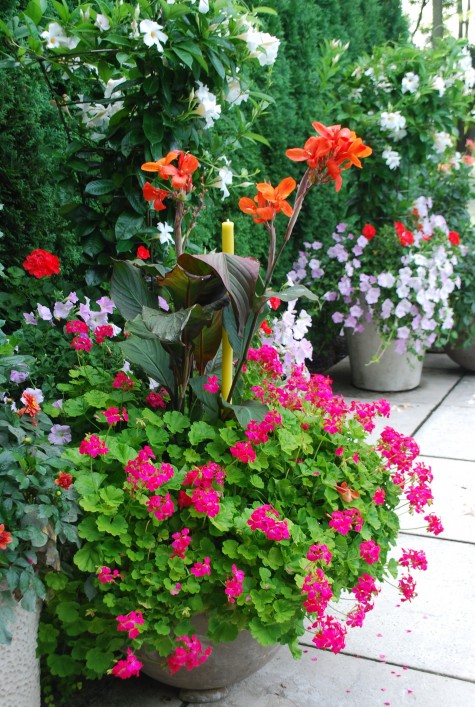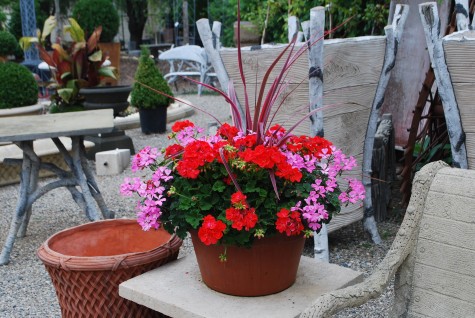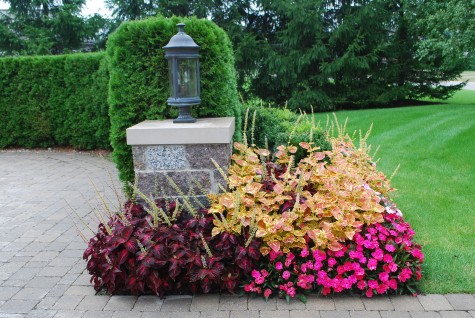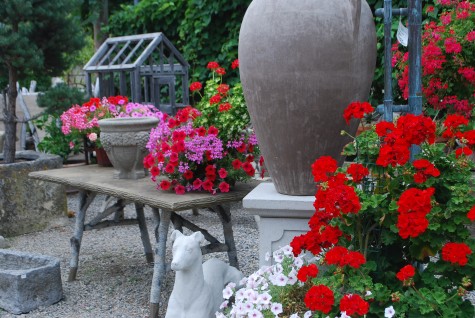 Does it not seem like the colors of all the annual flowers intensify with their first brush with cooler weather?
Does it not seem like the colors of all the annual flowers intensify with their first brush with cooler weather?
At A Glance: The Super-Nova Stage
Red, Pink and Light

Reams have been written about the science and psychology of color. I doubt I have much to add to that discussion beyond saying that no small amount of the pleasure I take in gardening involves tinkering with color. One of the best parts of annual gardening is that my committment to a composition is for one season only. I so like the chance to start over. My annual plantings are a brand new party dress for my garden-the color of which gives me lots of pleasure. There are few colors I do not like; though I am not a fan of grey, I planted the front of the shop last week with lots of silver grey foliage. Planting a scheme which has a good possibility of not appealing to me is part of the fun it. OK, maybe my idea of fun is a little offbeat-but so be it. Strong color has always appealed to me; how I express strong color depends on the effect I hope to achieve. Pink and red make a great color combination. The above pictured pots are based on a pink and red scheme, but the effect is formal and elegant.

Park Princess dahlias are as big a statement about pink as one could hope for. Were I to pair this plant with orange geraniums and yellow boston daisies, or red cannas, the effect of the color would be hot and tropical. As I was after a more formal and restrained expression of color in the planting, the pink and red I have leavened with lavender and pale pink. Light colors have the added property of reading well front a distance; these front porch pots make as much visual sense from a distance as they do up close.

Tickled Pink million bells are a strong red violet at the throat, but the overall color reads as light, almost white, and airy. They help to take some of the heat out of the purple wave petunias in this pot. The variegated licorice acts like lots of ice cubes in this big drink of magenta red violet. Had I used lime licorice here, and orange millions bells, the effect of the color would have been much different. The color is there, but expressed in a more restrained way.
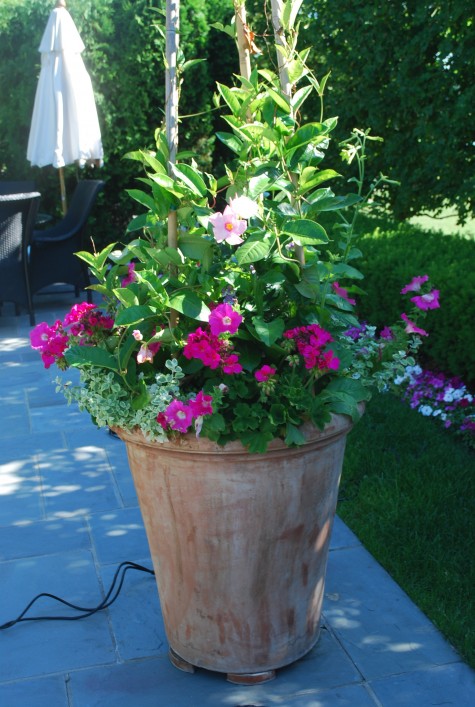 Once the pale pink mandevillea and lime nicotiana in this pot gets going, it will read in cool contrast to the cherry red geraniums and pink petunias. Hot and light colors mixed together is visually lively. Considering some of the ways in which color works will produce better and more satisfying containers.
Once the pale pink mandevillea and lime nicotiana in this pot gets going, it will read in cool contrast to the cherry red geraniums and pink petunias. Hot and light colors mixed together is visually lively. Considering some of the ways in which color works will produce better and more satisfying containers.
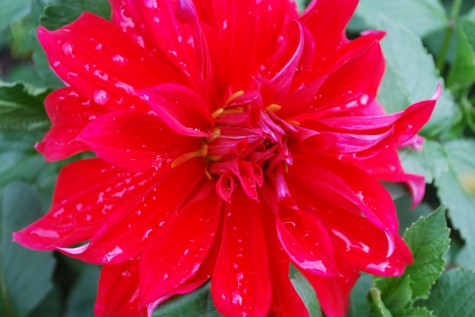 Red flowers can be dramatic in a landscape, as red and green contrast sharply. Red is most effective when viewed up close, or when the dose of red is a big dose. Red tulips, poppies, dahlias, geraniums, solenia begonias-they represent the color red effectively. Red mandevillea grows vigorously, and blooms heavily. Should red be your pleasure, any of these plants can deliver. Red caladiums are a different experience of red. The red color is overlaid on a green leaf; the visual effect is muted.
Red flowers can be dramatic in a landscape, as red and green contrast sharply. Red is most effective when viewed up close, or when the dose of red is a big dose. Red tulips, poppies, dahlias, geraniums, solenia begonias-they represent the color red effectively. Red mandevillea grows vigorously, and blooms heavily. Should red be your pleasure, any of these plants can deliver. Red caladiums are a different experience of red. The red color is overlaid on a green leaf; the visual effect is muted.
 I plant lots of geraniums-they are the little black dress of the annual world. It is no wonder so many people plant them-the color is striking. But pairing red geraniums with pink petunias, or strawberries, yellow dahlberg daisies or lavender star trailing verbena can make that red look like a fresh idea.
I plant lots of geraniums-they are the little black dress of the annual world. It is no wonder so many people plant them-the color is striking. But pairing red geraniums with pink petunias, or strawberries, yellow dahlberg daisies or lavender star trailing verbena can make that red look like a fresh idea.
 The big shot of bold color from these solenia pink begonias is the star of the show on this side porch. All the other plants lay low, in support of the dominant scheme.
The big shot of bold color from these solenia pink begonias is the star of the show on this side porch. All the other plants lay low, in support of the dominant scheme.
 Persian Queen geraniums are so versatile in a container planting. The lime green leaf is electric when paired with red; the flower is an equally electric pink. This discussion of pink is entirely different than the neighboring pots-but all the pots are friendly to one another.
Persian Queen geraniums are so versatile in a container planting. The lime green leaf is electric when paired with red; the flower is an equally electric pink. This discussion of pink is entirely different than the neighboring pots-but all the pots are friendly to one another.
 Pink and red geraniums alternating in the series of pots on a flight of steps get an alternating underplanting as well. I like garden ideas that are expressed clearly. Once I make a decision about where I want to go with color, I try to express that decision in as many subtly varying ways as I can. This endows individual pots with distinctively different compositions that still work well together overall. The planting has a rhythm and visual interest that helps make the flight up or down an interesting one.
Pink and red geraniums alternating in the series of pots on a flight of steps get an alternating underplanting as well. I like garden ideas that are expressed clearly. Once I make a decision about where I want to go with color, I try to express that decision in as many subtly varying ways as I can. This endows individual pots with distinctively different compositions that still work well together overall. The planting has a rhythm and visual interest that helps make the flight up or down an interesting one.

